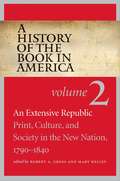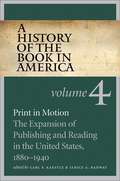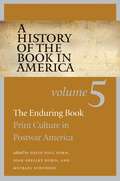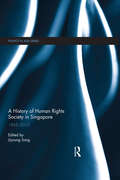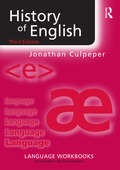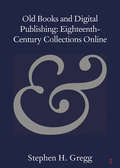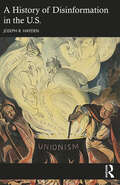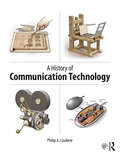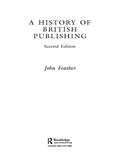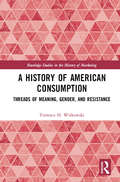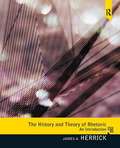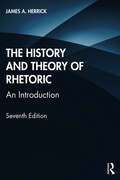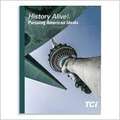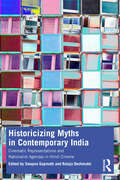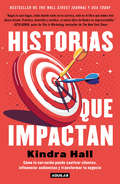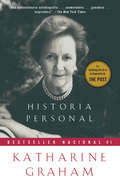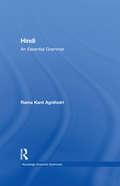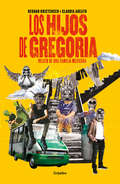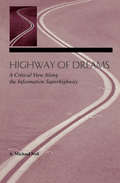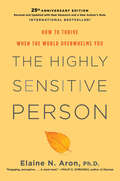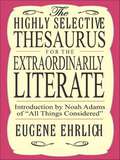- Table View
- List View
A History of the Book in America, 5-volume Omnibus E-book
by David D. HallThe five volumes in A History of the Book in America offer a sweeping chronicle of our country's print production and culture from colonial times to the end of the twentieth century. This interdisciplinary, collaborative work of scholarship examines the book trades as they have developed and spread throughout the United States; provides a history of U.S. literary cultures; investigates the practice of reading and, more broadly, the uses of literacy; and links literary culture with larger themes in American history.Now available for the first time, this complete Omnibus ebook contains all 5 volumes of this landmark work.Volume 1The Colonial Book in the Atlantic WorldEdited by Hugh Amory and David D. Hall664 pp., 51 illus.Volume 2An Extensive Republic: Print, Culture, and Society in the New Nation, 1790-1840Edited by Robert A. Gross and Mary Kelley712 pp., 66 illus.Volume 3The Industrial Book, 1840-1880Edited by Scott E. Casper, Jeffrey D. Groves, Stephen W. Nissenbaum, and Michael Winship560 pp., 43 illus.Volume 4Print in Motion: The Expansion of Publishing and Reading in the United States, 1880-1940Edited by Carl F. Kaestle and Janice A. Radway688 pp., 74 illus.Volume 5The Enduring Book: Print Culture in Postwar AmericaEdited by David Paul Nord, Joan Shelley Rubin, and Michael Schudson632 pp., 95 illus.
A History of the Book in America
by Robert A. Gross Mary KelleyVolume Two of A History of the Book in America documents the development of a distinctive culture of print in the new American republic.Between 1790 and 1840 printing and publishing expanded, and literate publics provided a ready market for novels, almanacs, newspapers, tracts, and periodicals. Government, business, and reform drove the dissemination of print. Through laws and subsidies, state and federal authorities promoted an informed citizenry. Entrepreneurs responded to rising demand by investing in new technologies and altering the conduct of publishing. Voluntary societies launched libraries, lyceums, and schools, and relied on print to spread religion, redeem morals, and advance benevolent goals. Out of all this ferment emerged new and diverse communities of citizens linked together in a decentralized print culture where citizenship meant literacy and print meant power. Yet in a diverse and far-flung nation, regional differences persisted, and older forms of oral and handwritten communication offered alternatives to print. The early republic was a world of mixed media.Contributors: Elizabeth Barnes, College of William and MaryGeorgia B. Barnhill, American Antiquarian SocietyJohn L. Brooke, The Ohio State UniversityDona Brown, University of VermontRichard D. Brown, University of ConnecticutKenneth E. Carpenter, Harvard University LibrariesScott E. Casper, University of Nevada, RenoMary Kupiec Cayton, Miami UniversityJoanne Dobson, Brewster, New YorkJames N. Green, Library Company of PhiladelphiaDean Grodzins, Massachusetts Historical SocietyRobert A. Gross, University of ConnecticutGrey Gundaker, College of William and MaryLeon Jackson, University of South CarolinaRichard R. John, Columbia UniversityMary Kelley, University of MichiganJack Larkin, Clark UniversityDavid Leverenz, University of FloridaMeredith L. McGill, Rutgers UniversityCharles Monaghan, Charlottesville, VirginiaE. Jennifer Monaghan, Brooklyn College of The City University of New YorkGerald F. Moran, University of Michigan-DearbornKaren Nipps, Harvard UniversityDavid Paul Nord, Indiana UniversityBarry O'Connell, Amherst CollegeJeffrey L. Pasley, University of Missouri-ColumbiaWilliam S. Pretzer, Central Michigan UniversityA. Gregg Roeber, Pennsylvania State UniversityDavid S. Shields, University of South CarolinaAndie Tucher, Columbia UniversityMaris A. Vinovskis, University of MichiganSandra A. Zagarell, Oberlin College
A History of the Book in America
by Janice A. Radway Carl F. KaestleIn a period characterized by expanding markets, national consolidation, and social upheaval, print culture picked up momentum as the nineteenth century turned into the twentieth. Books, magazines, and newspapers were produced more quickly and more cheaply, reaching ever-increasing numbers of readers. Volume 4 of A History of the Book in America traces the complex, even contradictory consequences of these changes in the production, circulation, and use of print. Contributors to this volume explain that although mass production encouraged consolidation and standardization, readers increasingly adapted print to serve their own purposes, allowing for increased diversity in the midst of concentration and integration. Considering the book in larger social and cultural networks, essays address the rise of consumer culture, the extension of literacy and reading through schooling, the expansion of secondary and postsecondary education and the growth of the textbook industry, the growing influence of the professions and their dependence on print culture, and the history of relevant technology. As the essays here attest, the expansion of print culture between 1880 and 1940 enabled it to become part of Americans' everyday business, social, political, and religious lives. Contributors:Megan Benton, Pacific Lutheran UniversityPaul S. Boyer, University of Wisconsin-MadisonUna M. Cadegan, University of DaytonPhyllis Dain, Columbia UniversityJames P. Danky, University of Wisconsin-MadisonEllen Gruber Garvey, New Jersey City UniversityPeter Jaszi, American UniversityCarl F. Kaestle, Brown UniversityNicolas Kanellos, University of HoustonRichard L. Kaplan, ABC-Clio PublishingMarcel Chotkowski LaFollette, Washington, D.C.Elizabeth Long, Rice UniversityElizabeth McHenry, New York UniversitySally M. Miller, University of the PacificRichard Ohmann, Wesleyan UniversityJanice A. Radway, Duke UniversityJoan Shelley Rubin, University of RochesterJonathan D. Sarna, Brandeis UniversityCharles A. Seavey, University of Missouri, ColumbiaMichael Schudson, University of California, San DiegoWilliam Vance Trollinger Jr., University of DaytonRichard L. Venezky (1938-2004)James L. W. West III, Pennsylvania State UniversityWayne A. Wiegand, Florida State UniversityMichael Winship, University of Texas at AustinMartha Woodmansee, Case Western Reserve UniversityThe contributors are Megan Benton, Paul S. Boyer, Una M. Cadegan, Phyllis Dain, James P. Danky, Ellen Gruber Garvey, Peter Jaszi, Carl F. Kaestle, Nicolas Kanellos, Richard L. Kaplan, Marcel Chotkowski LaFollette, Elizabeth Long, Elizabeth McHenry, Sally M. Miller, Richard Ohmann, Janice A. Radway, Joan Shelley Rubin, Jonathan D. Sarna, Charles A. Seavey, Michael Schudson, William Vance Trollinger Jr., Richard L. Venezky, James L. W. West III, Wayne A. Wiegand, Michael Winship, and Martha Woodmansee.-->
A History of the Book in America
by Michael Schudson Joan Shelley Rubin David Paul NordThe fifth volume of A History of the Book in America addresses the economic, social, and cultural shifts affecting print culture from World War II to the present. During this period factors such as the expansion of government, the growth of higher education, the climate of the Cold War, globalization, and the development of multimedia and digital technologies influenced the patterns of consolidation and diversification established earlier.The thirty-three contributors to the volume explore the evolution of the publishing industry and the business of bookselling. The histories of government publishing, law and policy, the periodical press, literary criticism, and reading--in settings such as schools, libraries, book clubs, self-help programs, and collectors' societies--receive imaginative scrutiny as well. The Enduring Book demonstrates that the corporate consolidations of the last half-century have left space for the independent publisher, that multiplicity continues to define American print culture, and that even in the digital age, the book endures.Contributors:David Abrahamson, Northwestern UniversityJames L. Baughman, University of Wisconsin-MadisonKenneth Cmiel (d. 2006)James Danky, University of Wisconsin-MadisonRobert DeMaria Jr., Vassar CollegeDonald A. Downs, University of Wisconsin-MadisonRobert W. Frase (d. 2003)Paul C. Gutjahr, Indiana UniversityDavid D. Hall, Harvard Divinity SchoolJohn B. Hench, American Antiquarian SocietyPatrick Henry, New York City College of TechnologyDan Lacy (d. 2001)Marshall Leaffer, Indiana UniversityBruce Lewenstein, Cornell UniversityElizabeth Long, Rice UniversityBeth Luey, Arizona State UniversityTom McCarthy, Beirut, LebanonLaura J. Miller, Brandeis UniversityPriscilla Coit Murphy, Chapel Hill, N.C.David Paul Nord, Indiana UniversityCarol Polsgrove, Indiana UniversityDavid Reinking, Clemson UniversityJane Rhodes, Macalester CollegeJohn V. Richardson Jr., University of California, Los AngelesJoan Shelley Rubin, University of RochesterMichael Schudson, University of California, San Diego, and Columbia UniversityLinda Scott, University of OxfordDan Simon, Seven Stories PressIlan Stavans, Amherst CollegeHarvey M. Teres, Syracuse UniversityJohn B. Thompson, University of CambridgeTrysh Travis, University of FloridaJonathan Zimmerman, New York University
A History of Human Rights Society in Singapore: 1965-2015 (Politics in Asia)
by Jiyoung SongTo celebrate Singapore’s fiftieth anniversary for its independence from Malaysia in 2015, 35 students, academics and activists came together to discuss and write about pioneering Singaporean human rights activists and their under-reported stories in Singapore. The city-state is known for its remarkable economic success while having strict laws on individual freedom in the name of national security, public order and racial harmony. Singapore’s tough stance on human rights, however, does not negate the long and persistent existence of a human rights society that is little known to the world until today. This volume, composed of nine distinctive chapters, records a history of human rights activists, their campaigns, main contentions with the government, survival strategies and other untold stories in Singapore’s first 50 years of state-building.
History of English (Language Workbooks)
by Jonathan CulpeperRoutledge Language Workbooks provide absolute beginners with practical introductions to core areas of language study. Books in the series provide comprehensive coverage of the area as well as a basis for further investigation. Each Language Workbook guides the reader through the subject using ‘hands-on’ language analysis, equipping them with the basic analytical skills needed to handle a wide range of data. Written in a clear and simple style, with all technical concepts fully explained, Language Workbooks can be used for independent study or as part of a taught class. History of English: • examines the history of the English language in order to explain the English that is used today • introduces key linguistic concepts • provides ‘discussion points’ to generate debate • encourages readers to think critically about the subject • involves readers in collecting and analysing their own data • contains a ‘mini-corpus’ of texts, used for exercises and to illustrate points raised in the commentary Revised throughout, this updated edition integrates the latest research on the history of English, including an additional chapter on English letters and punctuation, and an updated bibliography. History of English, 3rd edition provides an essential introduction and workbook for students coming to this subject for the first time.
The History of Eighteenth-Century Collections Online (Elements in Publishing and Book Culture)
by Stephen H. GreggThis is a history of Eighteenth-Century Collections Online, a database of over 180,000 titles. Published by Gale in 2003 it has had an enormous impact of the study of the eighteenth century. Like many commercial digital archives, ECCO's continuing development obscures its precedents. This Element examines its prehistory as, first, a computer catalogue of eighteenth-century print, and then as a commercial microfilm collection, before moving to the digitisation and development of the interfaces to ECCO, as well as Gale's various partnerships and licensing deals. An essential aspect of this Element is how it explores the socio-cultural and technological debates around the access to old books from the 1930s to the present day: Stephen Gregg demonstrates how these contexts powerfully shape the way ECCO works to this day. The Element's aim is to make us better users and better readers of digital archives.
A History of Disinformation in the U.S.
by Joseph R. HaydenThis volume recounts notable episodes of distortion throughout American media history. It examines several of the lurid hoaxes and conspiracy theories that have inspired press coverage, as well as some of the political lies promoted by partisan gladiators, whether of the eighteenth century or today.The book moves beyond the sensational stories to show the enduring and systemic nature of media manipulation that occurs on far more consequential issues. It exposes persistent and deeply destructive falsehoods that have been told about women, people of color, immigrants, the LGBTQ+ community, unions, commercial products, highlighting how longstanding “bipartisan” myths have effectively marginalized certain groups of Americans. Alongside these cases, the author carefully dissects the changing nature of institutions, technologies, and practices of journalism in America. Attention is given to the evolution of newspapers in the eighteenth and nineteenth centuries, the role of broadcasting in the twentieth, and the impact of the internet and social media at the dawn of the twenty-first.This book will appeal to readers interested in American history, journalism, communication studies, political science and sociology.
A History of Communications
by Marshall T. PoeA History of Communications advances a new theory of media that explains the origins and impact of different forms of communication – speech, writing, print, electronic devices and the Internet – on human history in the long term. New media are 'pulled' into widespread use by broad historical trends and these media, once in widespread use, 'push' social institutions and beliefs in predictable directions. This view allows us to see for the first time what is truly new about the Internet, what is not, and where it is taking us.
A History of Communication Technology
by Philip LoubereThis book is a comprehensive illustrated account of the technologies and inventions in mass communication that have accelerated the advancement of human culture and society. A History of Communication Technology covers a timeline in the history of mass communication that begins with human prehistory and extends all the way to the current digital age. Using rich, full-color graphics and diagrams, the book details the workings of various mass communication inventions, from paper-making, printing presses, photography, radio, TV, film, and video, to computers, digital devices, and the Internet. Readers are given insightful narratives on the social impact of these technologies, brief historical accounts of the inventors, and sidebars on the related technologies that enabled these inventions. This book is ideal for students in introductory mass communication, visual communication, and history of media courses, offering a highly approachable, graphic-oriented approach to the history of communication technologies.
A History of British Publishing
by John FeatherThoroughly revised, restructured and updated, A History of British Publishing covers six centuries of publishing in Britain from before the invention of the printing press, to the electronic era of today. John Feather places Britain and her industries in an international marketplace and examines just how ‘British’, British publishing really is. Considering not only the publishing industry itself, but also the areas affecting, and affected by it, Feather traces the history of publishing books in Britain and examines: education politics technology law religion custom class finance, production and distribution the onslaught of global corporations. Specifically designed for publishing and book history courses, this is the only book to give an overall history of British publishing, and will be an invaluable resource for all students of this fascinating subject.
A History of American Consumption: Threads of Meaning, Gender, and Resistance (Routledge Studies in the History of Marketing)
by Terrence H. WitkowskiThe United States has been near the forefront of global consumption trends since the 1700s, and for the past century and more, Americans have been the world’s foremost consuming people. Informed and inspired by the literature from consumer culture theory, as well as drawing from numerous studies in social and cultural history, A History of American Consumption tells the story of the American consumer experience from the colonial era to the present, in three cultural threads. These threads recount the assignment of meaning to possessions and consumption, the gendered ideology and allocation of consumption roles, and resistance through anti-consumption thought and action. Brief but scholarly, this book provides a thought provoking, introduction to the topic of American consumption history informed by research in consumer culture theory. By examining and explaining the core phenomenon of product consumption and its meaning in the changing lives of Americans over time, it provides a valuable contribution to the literature on the subjects of consumption and its causes and consequences. Readable and insightful, it will be of interest to scholars and advanced students in consumer behaviour, advertising, and marketing and business history.
History in the Making: The Story of the American Printing House for the Blind 1858-2008
by Carol Brenner TobeThis beautifully illustrated 150th Anniversary book celebrates the history of the American Printing House for the Blind (which is based in Louisville, Kentucky) and examines its mission to provide specialized materials, books, products, and services to the visually impaired. Author Carol Tobe guides the reader through all of the Printing House's mechanical innovations and evolutions right up to today's digital solutions. Hundreds of color photographs showcase the Printing House, its people, and machines of the past and present. Its story is virtually the story of blind people in America.
The History and Theory of Rhetoric: An Introduction (Subscription)
by James A. HerrickThe History and Theory of Rhetoric offers discussion of the history of rhetorical studies in the Western tradition, from ancient Greece to contemporary American and European theorists that is easily accessible to students. By tracing the historical progression of rhetoric from the Greek Sophists of the 5th Century B.C. all the way to contemporary studies-such as the rhetoric of science and feminist rhetoric-this comprehensive text helps students understand how persuasive public discourse performs essential social functions and shapes our daily worlds. Students gain conceptual framework for evaluating and practicing persuasive writing and speaking in a wide range of settings and in both written and visual media. Known for its clear writing style and contemporary examples throughout, The History and Theory of Rhetoric emphasizes the relevance of rhetoric to today's students.
The History and Theory of Rhetoric: An Introduction
by James A. HerrickBy tracing the traditional progression of rhetoric from the Greek Sophists to contemporary theorists, this textbook gives students a conceptual framework for evaluating and practicing persuasive writing and speaking in a wide range of settings and in both written and visual media. The book’s expansive historical purview illustrates how persuasive public discourse performs essential social functions and shapes our daily worlds, drawing on the ideas of some of history’s greatest thinkers and theorists. The seventh edition includes greater attention to non-Western rhetorics, feminist rhetorics, the rhetoric of science, and European and American critical theory. Known for its clear writing style and contemporary examples throughout, The History and Theory of Rhetoric emphasizes the relevance of rhetoric to today’s students. This revised edition serves as a core textbook for rhetoric courses in both English and communication programs covering both the historical tradition of rhetoric and contemporary rhetoric studies. This edition includes an instructor’s manual and practice quizzes for students at www.routledge.com/cw/herrick
History Alive! Pursuing American Ideals
by Diane HartBy using this program, the students will discover how the skills of social sciences are used to explore the history of the United States. The print and online components of this program provide the tools needed for a complete learning cycle. Each unit begins with an online Unit Opener to prepare for inquiry--asking questions and proposing supported answers and solutions. Each lesson with a Lesson Guide preview activity that engages inquiry and sets a foundation for the lesson's content. In the Lesson Guide, student will participate in an interactive activity that connects to both the C3 Framework and English Language Arts and literacy. In these activities, they will use the tools of social studies inquiry: asking questions, using sources and other evidence to develop claims, and communicating conclusions. The lesson concludes as the readers demonstrate their knowledge of the lesson's core ideas and the inquiry process through a variety of paper and online Assessments.
Historicizing Myths in Contemporary India: Cinematic Representations and Nationalist Agendas in Hindi Cinema
by Swapna Gopinath Rutuja DeshmukhThis book examines cinematic practices in Bollywood as narratives that assist in shaping the imagination of the age, especially in contemporary India. It examines historical films released in India since the new millennium and analyses cinema as a reflection of the changing socio-political and economic conditions at any given period. The chapters in Historicizing Myths in Contemporary India: Cinematic Representations and Nationalist Agendas in Hindi Cinemas also illuminate different perspectives on how cinematic historical representations follow political patterns and market compulsions, giving precedence to a certain past over the other, creating a narrative suited for the dominant narrative of the present. From Mughal-e-Azam to Padmaavat, and Bajirao Mastani to Raazi, the chapters show how creating history out of myths validate hegemonic identities in a rapidly evolving Indian society. The volume will be of interest to scholars of film and media studies, literature and culture studies, and South Asian studies.
Historias que impactan: Cómo la narración puede cautivar clientes, influenciar audiencias y transformar
by Kindra HillEn el momento en que tomas el control de tus historias, tomas el control de tu negocio y de tu vida. "Hagas lo que hagas, estés donde estés en tu carrera, este es el libro que debes leer ahora mismo. Práctico, divertido y verídico, el nuevo libro de Kindra es imprescindible." -SETH GODIN, autor de This Is Marketing, bestseller de The New York Times Seguramente has escuchado que las historias son la mejor herramienta de negocios y que la narración de las mismas puede hacerlo todo, desde ayudar a los líderes a comunicarse mejor hasta motivar a los equipos de ventas y ganar clientes de la competencia. ¿Pero cuáles necesitas contar? ¿Y cómo hacerlo? En este libro, Kindra Hall, una reconocida narradora profesional y oradora, revela las cuatro historias únicas que puedes usar para diferenciar, cautivar y elevar: -La historia del valor: para convencer a los clientes de que necesitan lo que tú ofreces. -La historia de la fundación: para persuadir a los inversores y clientes de que vale la pena invertir en tu organización. -La historia del propósito: para alinear e inspirar a tus empleados y clientes internos. -La historia del consumidor: para permitir que aquellos que utilizan tu producto o servicio compartan tus experiencias auténticas con otros. Contarlas bien es una habilidad simple y accesible que cualquiera puede desarrollar. Con estudios de casos, perfiles de empresas y anécdotas respaldados por investigaciones, Kindra ofrece pasos específicos y accionables que puedes tomar para encontrar, crear y aprovechar las historias que ya tienes y que simplemente no estás contando.
Historia Personal: Mujer, Periodista, Empresaria, Editora De The Washington Post (Alianza Actualidad Ser.)
by Katharine GrahamPREMIO PULITZER DE BIOGRAFÍAAHORA EN LA GRAN PANTALLAEn esta aclamada autobiografía y bestseller internacional, Katharine Graham, la mujer que lideró el Washington Post a través de la crisis de los “Papeles del Pentágono” y el escándalo de Watergate, cuenta su historia extraordinaria, tanto por los eventos que abarca como por el coraje, la franqueza y la dignidad de su narración. Nos encontramos con a la niña torpe que creció en medio de la riqueza material y el aislamiento emocional; la joven novia que vio cómo su brillante y carismático esposo, confidente de John F. Kennedy y Lyndon Johnson, caía en la enfermedad mental que culminaría en su suicidio. Pero también encontramos a la viuda que sacudió su dolor e inseguridad para enfrentarse a un presidente y un sindicato de prensa mientras ingresaba cautelosamente en el negocio de los periódicos, en ese entonces liderado por hombres. Incansablemente reveladora, elegantemente escrita, Historia personal es un registro ejemplar de nuestro tiempo y de la mujer que desempeñó un papel ejemplar, descubriendo su propia fuerza y confianza en sí misma al enfrentar y dominar las crisis personales y profesionales de una vida extraordinariamente fascinante.
Hindi: An Essential Grammar (Routledge Essential Grammars)
by Rama Kant AgnihotriThis text provides a reader-friendly guide to the structural patterns of modern standard Hindi. Ideal for both independent learners and classroom students alike, this book covers the essentials of Hindi grammar in readable, jargon-free sections. Key features include: sections on the speech sounds of Hindi detailed analysis of Hindi sentence structure full examples throughout.
Hillary Clinton in the News: Gender and Authenticity in American Politics
by Shawn J. Parry-GilesThe charge of inauthenticity has trailed Hillary Clinton from the moment she entered the national spotlight and stood in front of television cameras. Hillary Clinton in the News: Gender and Authenticity in American Politics shows how the U.S. news media created their own news frames of Clinton's political authenticity and image-making, from her participation in Bill Clinton's 1992 presidential campaign through her own 2008 presidential bid. Using theories of nationalism, feminism, and authenticity, Parry-Giles tracks the evolving ways the major networks and cable news programs framed Clinton's image as she assumed roles ranging from surrogate campaigner, legislative advocate, and financial investor to international emissary, scorned wife, and political candidate. This study magnifies how the coverage that preceded Clinton's entry into electoral politics was grounded in her earliest presence in the national spotlight, and in long-standing nationalistic beliefs about the boundaries of authentic womanhood and first lady comportment. Once Clinton dared to cross those gender boundaries and vie for office in her own right, the news exuded a rhetoric of sexual violence. These portrayals served as a warning to other women who dared to enter the political arena and violate the protocols of authentic womanhood.
Los hijos de Gregoria: Relato de una familia mexicana
by Claudia Adeath Regnar Kristensen«Los hijos de Gregoria vuelve a mirar hacia Los hijos de Sánchez más de cincuenta años después, en un momento en que la economía criminal (robo, drogas, guerra de pandillas) ha alcanzado un nivel mucho más alto. Basado en una profunda empatía y con la confianza de cada uno de los protagonistas del libro, este relato literario y etnográfico evita los juicios de valor y ofrece un recuento honesto de las experiencias de las personas que han sufrido mucho y que han causado mucho sufrimiento.» Claudio Lomnitz Los hijos de Gregoria es un impactante libro testimonial, el crudo relato de una familia mexicana que, como muchas otras, a lo largo ya de varias generaciones, ha sido víctima del fracaso de las políticas sociales en México. Por cerca de ocho años, Regnar Kristensen y Claudia Adeath se dieron a la tarea de entrevistar a Gregoria, a sus seis hijos y a otros miembros cercanos a la familia, para luego recopilar sus historias, atravesadas por las carencias, la falta de educación, la violencia y, sorpresivamente, por la fe, la lealtad y la tragicomedia. Es precisamente esta narración polifónica, este contar de viva voz, lo que retrata a detalle la realidad brutal de lo que día a día ocurre en Esperanza, el barrio en el que viven Goya y los suyos. En la misma línea de Los hijos de Sánchez, de Oscar Lewis, esta investigación, que sigue además un manifiesto personal, desentraña sin piedad las dinámicas familiares en México.
Highway of Dreams: A Critical View Along the Information Superhighway (LEA Telecommunications Series)
by A. Michael NollThis important volume reviews the history of the telecommunication superhighway pointing out its beginnings in the interactive TV and broadband highway of the wired cities more than two decades ago. It explains the technological uncertainties of the superhighway and many of its futuristic services, and also gives an understandable review of the technological principles behind today's modern telecommunication networks and systems. Recognizing that technology is only one factor in shaping the future, the author, a well-recognized telecommunications expert, analyzes the financial, policy, business, and consumer issues that undermine the superhighway. The book concludes by showing that today's switched telephone network and CATV systems already form a telecommunication superhighway carrying voice, data, image, and video communication for a wide variety of services that enable us to stay in contact with anyone anywhere on our planet. Highway of Dreams is written clearly with understandable explanations for nonspecialists. It challenges the technological utopia offered by the promoters of the superhighway and suggests that consumer needs, finance, corporate culture, and policy often have far greater impact on the future than technology alone.
The Highly Sensitive Person: How To Thrive When The World Overwhelms You
by Elaine N. AronAre You A Highly Sensitive Person?Do you have a keen imagination and vivid dreams? Is time alone each day as essential to you as food and water? Are you "too shy" or "too sensitive" according to others? Do noise and confusion quickly overwhelm you? If your answers are yes, you may be a Highly Sensitive Person (HSP). Most of us feel overstimulated every once in a while, but for the HSP, it's a way of life. In this groundbreaking book, Dr. Elaine Aron, a clinical psychologist, workshop leader, and an HSP herself, shows you how to identify this trait in yourself and make the most of it in everyday situations. Drawing on her many years of research and hundreds of interviews, she shows how you can better understand yourself and your trait to create a fuller, richer life. Updated with a new Author's Note, including the latest scientific research, and a fresh discussion of anti-depressants for HSPs, this edition of The Highly Sensitive Person also includes: Self-assessment tests to help you identify your particular sensitivitiesWays to reframe your past experiences in a positive light and gain greater self-esteem in the processInsight into how high sensitivity affects both work and personal relationshipsTips on how to deal with overarousalInformation on medications and when to seek helpTechniques to enrich the soul and spirit"Elaine Aron's perceptive analysis of this fundamental dimension of human nature is must reading. Her balanced presentation suggests new paths for making sensitivity a blessing, not a handicap." --Philip G. Zimbardo, author of Shyness"Enlightening and empowering, this book is a wonderful gift to us all." -Riane Ensler, author of The Chalice and the Blade
The Highly Selective Thesaurus for the Extraordinarily Literate (Highly Selective Reference)
by Eugene EhrlichAnyone looking to improve his or her vocabulary and anyone who loves words will be enthralled by this unique and impressive thesaurus that provides only the most unusual -- or is it recondite? --words for each entry.

